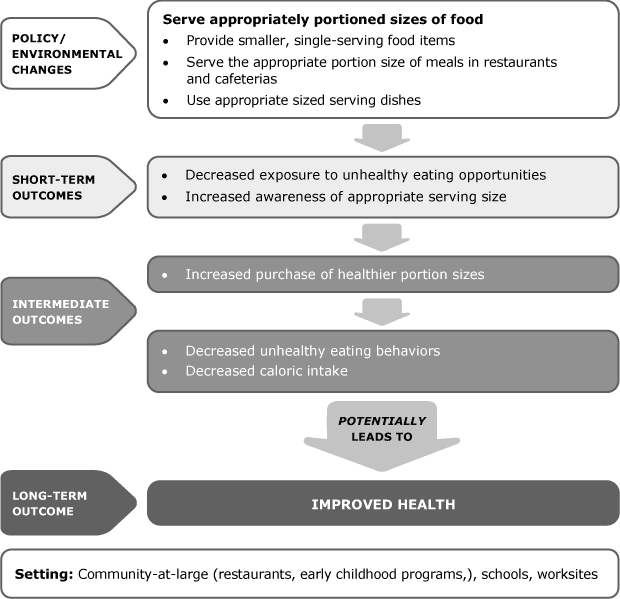Our Healthier Communities
Our Healthier Communities Initiatives are built on the concept that local communities can work together to give all community members healthy choices and support the pursuit of healthy lifestyles. More than 160 Ys are working in collaboration with community leaders to make changes in policies and the physical surroundings in those communities so that healthy living is within reach for individuals of all ages and backgrounds.
Serve Appropriately Portioned Sizes of Food
Portion size significantly influences caloric intake. Changing portion size to a single serving can increase awareness of the appropriate portion size for food and beverage items.
Studies have found that portion size significantly influences caloric intake. That is, people were more likely to consume more calories when offered larger portion sizes. Furthermore, changing portion sizes to a single serving increased awareness of the appropriate portion sizes for food and beverage items. Decreasing the size of the bowl also reduced the serving size of the meal significantly. In an early childhood program setting, children increased their vegetable intake as portion sizes increased when a vegetable was offered as a first course. Changing portion sizes has the potential to lead to significant and sustained impact on food intake.
References
- Antonuk, B., & Block, L.G. (2006). The effect of single serving versus entire package nutritional information on consumption norms and actual consumption of a snack food. Journal of Nutrition Education and Behavior, 38(6), 365–370.
- Cullen, K.W., & Thompson, D.I. (2005). Texas school food policy changes related to middle school a la carte/snack bar foods: Potential savings in kilocalories. Journal of the American Dietetic Association, 105(12), 1952–1954.
- Diliberti, N., Bordi, P.L., Conklin, M.T., Roe, L.S., & Rolls, B.J. (2004). Increased portion size leads to increased energy intake in a restaurant meal. Obesity Research, 12(3), 562–568.
- Mendoza, J.A., Watson, K., & Cullen, K.W. (2010). Changes in dietary energy density after implementation of the Texas Public School Nutrition Policy. Journal of the American Dietetic Association, 110(3), 434–440.
- Rolls, B.J., Morris, E.L., & Roe, L.S. (2002). Portion size of food affects energy intake in normal-weight and overweight men and women. American Journal of Clinical Nutrition, 76(6), 1207–1213.
- Rolls, B.J., Roe, L.S., & Meengs, J.S. (2006). Reductions in portion size and energy density of foods are additive and lead to sustained decreases in energy intake. American Journal of Clinical Nutrition, 83(1), 11–17.
- Spill, M.K., Birch, L.L., Roe, L.S., & Rolls, B.J. (2010). Eating vegetables first: the use of portion size to increase vegetable intake in preschool children. American Journal of Clinical Nutrition, 91, 1237–1243.
- Wansink, B., Just, D., & McKendr, J. (2010). Lunch line redesign. New York Times. http://www.nytimes.com/interactive/2010/10/21/opinion/20101021_Oplunch.html. Accessed November 15, 2010.

More Healthy Living Strategies
-
Healthy Eating Strategy #5
Healthy Living Strategies -
Healthy Eating Strategy #6
Healthy Living Strategies -
Healthy Eating Strategy #1
Healthy Living Strategies